The Japanese sword is more than just a weapon—it is a masterpiece of craftsmanship and samurai spirit. At the Tokyo Japanese Sword Museum, you can admire historic blades, learn the etiquette of handling a sword, and immerse yourself in the rich heritage.
- Displays historic samurai swords, including National Treasures and Important Cultural Properties.
- Showcases forging and polishing techniques, revealing the craftsmanship behind Japanese swords.
- Conveniently located near Ryogoku Station, making it easy to visit.
- Popular among fans of “Touken Ranbu“, attracting visitors interested in Japanese sword culture.
- Some areas and objects may be restricted from photography.
- Free monocular rental for detailed sword viewing.
- Café & shop offering sword-themed sweets and books.
- Located in Yasuda Garden, providing a serene Japanese garden experience.
- Discount for Sumida Hokusai Museum visitors with a ticket stub.

The museum is right next to Ryogoku Kokugikan, Tokyo’s famous sumo arena.
1 The Allure of the Japanese Sword

The Japanese sword is a unique creation that serves both as a weapon and a work of art. Its defining characteristics lie in its exceptional strength, achieved through repeated folding and forging, and its beautiful hamon (blade pattern).
By layering and hammering steel hundreds of times, swordsmiths create blades that are both incredibly durable and remarkably flexible. This craftsmanship, passed down since the age of the samurai, is now admired in museums and exhibitions as a symbol of Japanese culture.
For those eager to experience the world of Japanese swords firsthand, the Tokyo Japanese Sword Museum offers a rare opportunity to see historic masterpieces and appreciate the essence of traditional sword-making techniques.
2 What is the Japanese Sword Museum?

Located in Ryogoku, Tokyo, the Japanese Sword Museum is a rare institution dedicated to the preservation and exhibition of Japanese swords. Inside, visitors can admire National Treasures and Important Cultural Properties, including masterpieces from the Heian to Edo periods.
The museum regularly hosts special exhibitions showcasing the sword-making process and craftsmanship, offering deeper insight into the artistry behind Japanese swords.
A museum shop is also available, where visitors can purchase books and merchandise related to Japanese swords.
This museum is the perfect place to experience the beauty of Japanese swords up close, appreciate their historical significance, and gain a deeper understanding of the craftsmanship that defines them.
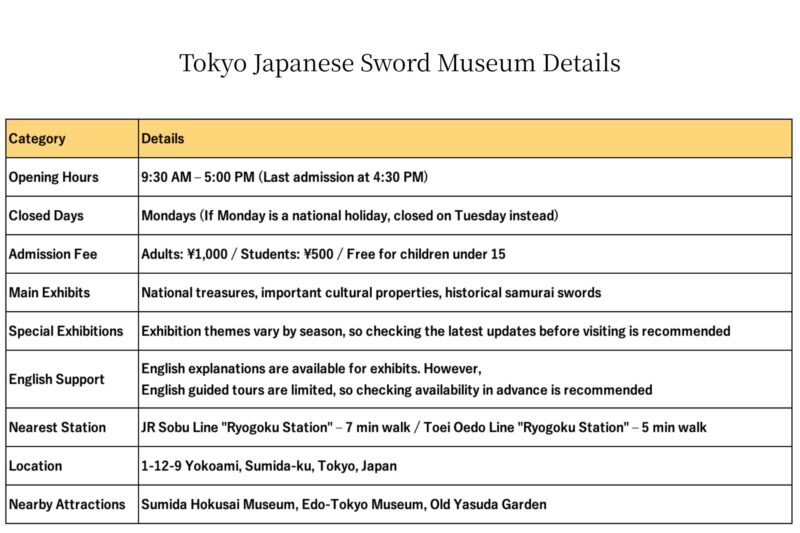
3 Types of Japanese Swords and Craftsmanship
3-1 Characteristics of “Tachi”, “Uchigatana”, and “Wakizashi”
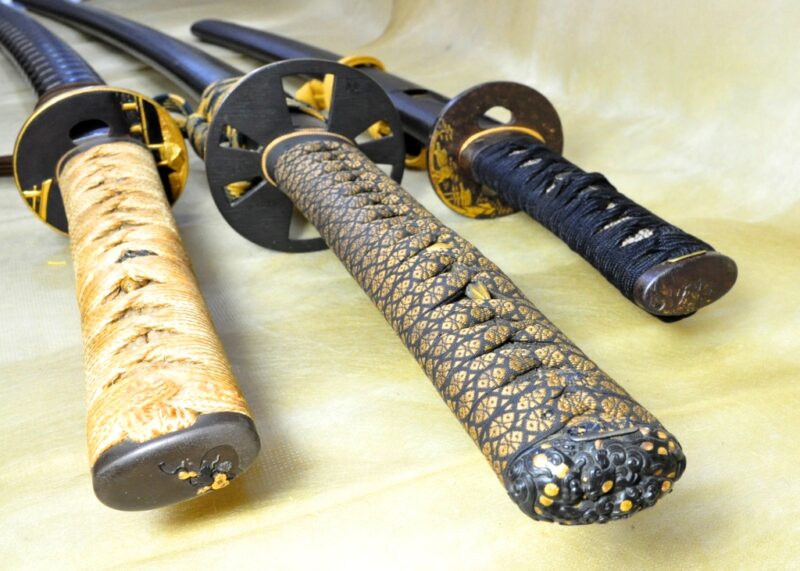
Japanese swords have evolved over time to suit different purposes and combat styles. Among them, Tachi, Uchigatana, and Wakizashi are the most representative types.
Tachi – The Symbol of the Samurai
Tachi was used from the Heian to Muromachi periods, primarily by mounted warriors. It was worn with the blade facing downward, suspended from the waist. The long, deeply curved blade gave it an elegant appearance. Famous examples include Dōjigiri Yasutsuna and Mikazuki Munechika, both designated as National Treasures.
Uchigatana – A Practical Combat Sword
Uchigatana became widespread from the Muromachi to Edo periods, designed for foot soldiers. Unlike Tachi, it was worn with the blade facing upward, allowing for quick draws in battle. Notable Uchigatana swords include Kashū Kiyomitsu and Yamato no Kami Yasusada, famously used by the Shinsengumi.
Wakizashi – A Complementary Sword
Wakizashi was carried alongside Uchigatana as a secondary weapon, useful for close combat and indoor fighting. It also served as a status symbol, required to be worn by samurai at all times. The legendary swordsman Miyamoto Musashi famously wielded a Wakizashi in his two-sword fighting style.
3-2 The Sword-Making Process: From Forging to Polishing
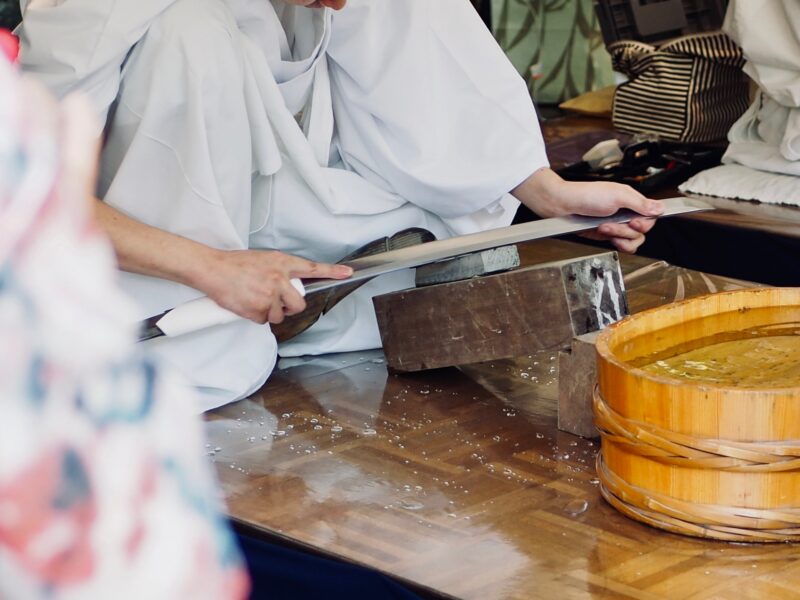
Japanese swords are crafted with exceptional skill, making them more than just weapons—they are works of art. The intricate process behind their creation gives them lasting cultural and artistic value.
Step 1: Forging – Strengthening the Steel The primary material for Japanese swords is tamahagane, a high-purity steel. Swordsmiths repeatedly fold and hammer the steel, refining its structure to achieve both durability and flexibility. This process ensures the blade’s resilience and sharpness.
Step 2: Quenching – Creating the Hamon Pattern The blade is heated to high temperatures and rapidly cooled in water or oil, hardening the steel and forming the hamon, a distinct wavy pattern along the edge. The hamon is both visually striking and a testament to the swordsmith’s expertise. To achieve the ideal balance of hardness and flexibility, the forging and quenching processes are repeated multiple times before the blade is finalized.
Step 3: Polishing – Enhancing the Sword’s Beauty A specialized polisher uses fine whetstones to refine the blade’s surface. This step sharpens the edge while bringing out the sword’s natural brilliance. The way light reflects off the polished steel highlights the craftsmanship and elegance unique to Japanese swords.

It seems that crafting a high-quality Japanese sword can take anywhere from a few months to several years.
4 How to Enjoy the Japanese Sword Museum and Visiting Tips
4-1 Interactive Exhibits
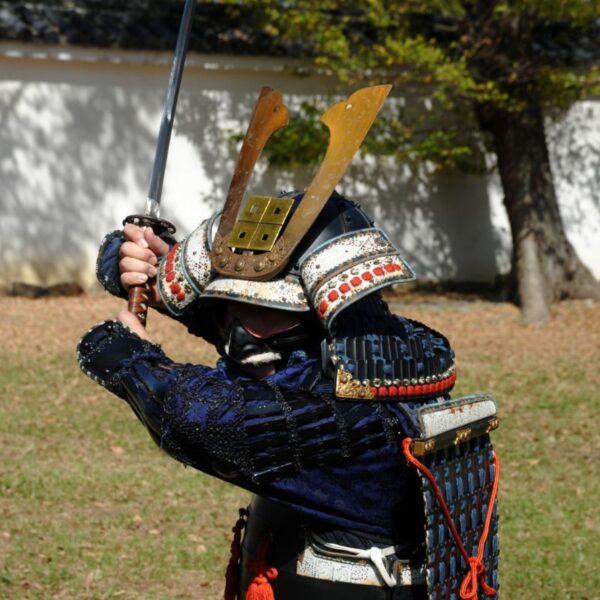
The museum offers engaging displays that showcase the beauty and craftsmanship of Japanese swords. Visitors can learn about sword-making techniques and history through expert-led exhibits. Replica displays allow guests to experience the weight and shape of a sword while also learning proper handling etiquette. Understanding how to appreciate and handle a sword enhances the cultural experience and deepens knowledge of Japanese sword traditions.

When I held a real Japanese sword, I was surprised by how solid and heavy it felt, much more than I had expected.
4-2 Pre-Visit Checklist
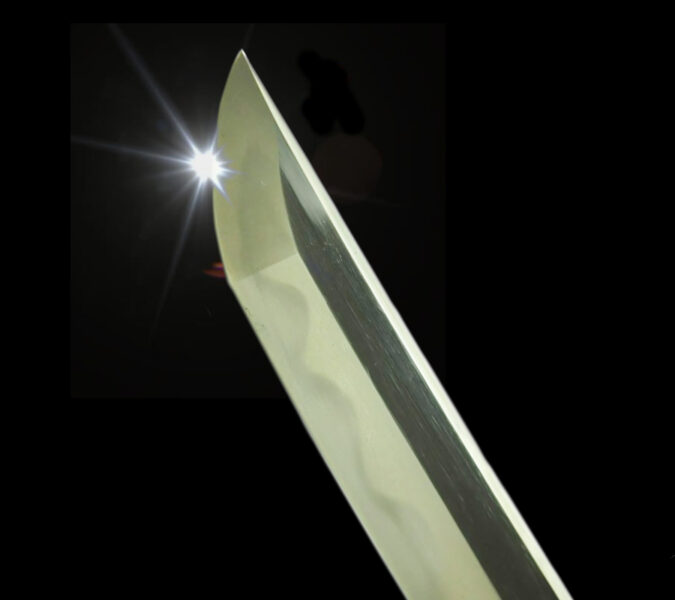
The museum offers free monocular rentals, allowing visitors to closely observe the hamon and intricate sword details. Some areas inside the building have photography restrictions, so checking with staff is recommended. Nearby cultural spots like the Sumida Hokusai Museum and the Edo-Tokyo Museum provide additional opportunities to enrich the experience.
Before visiting, review the available information and embark on a journey to explore the spirit of the samurai.

Whoa, the hamon pattern was stunning! And I couldn’t believe how brightly it shone!
5. Conclusion – A Journey to Experience the Spirit of the Samurai and the Passion of Swordsmiths
At the museum, visitors can not only admire legendary Japanese swords but also learn about proper handling and etiquette, deepening their understanding of this rich cultural tradition. Immerse yourself in the spirit of the samurai and discover the artistry of Japanese swords—step into this fascinating world. A reference document is provided below to enhance your experience.
RUROUNI KENSHIN Live Action Movie Trilogy | BEST SWORD FIGHT SCENES



Comments